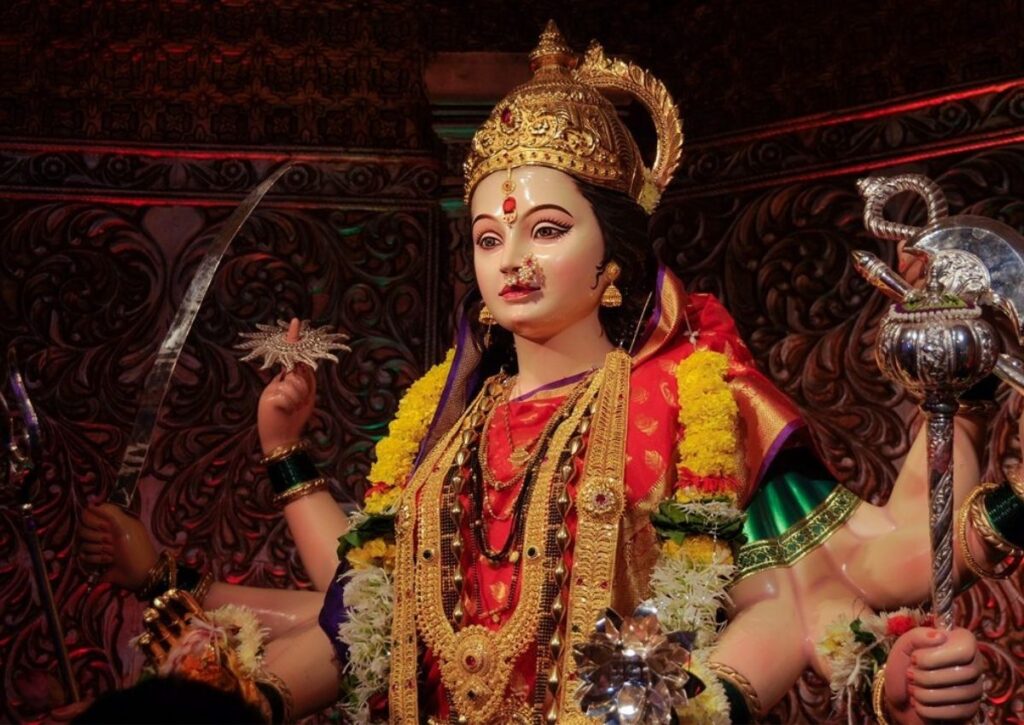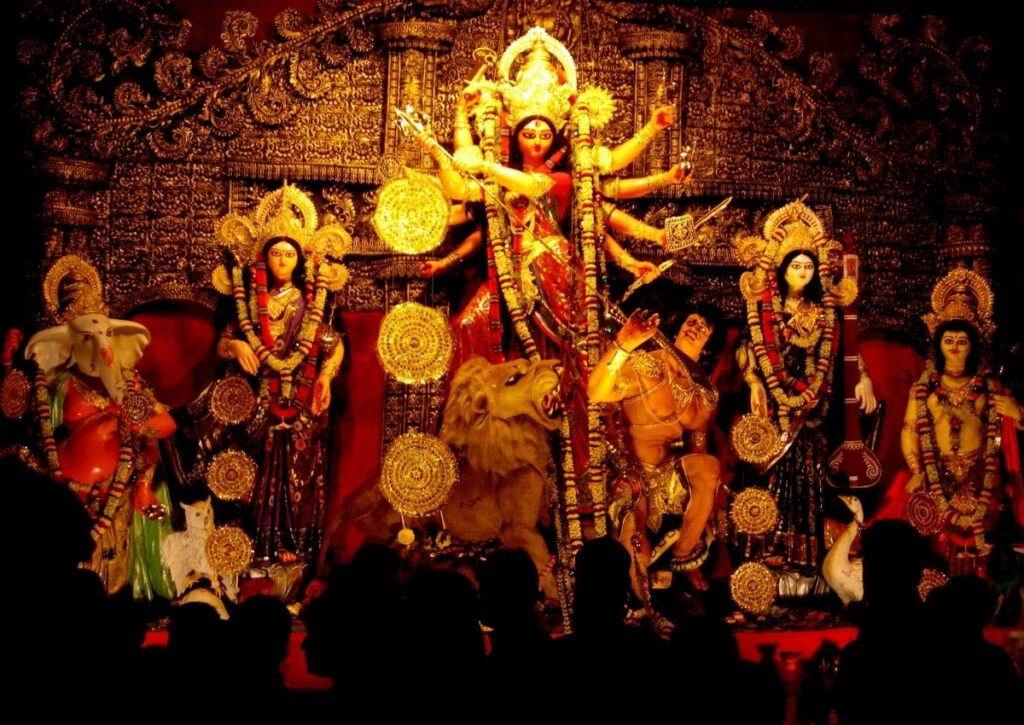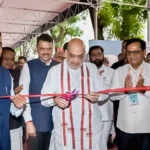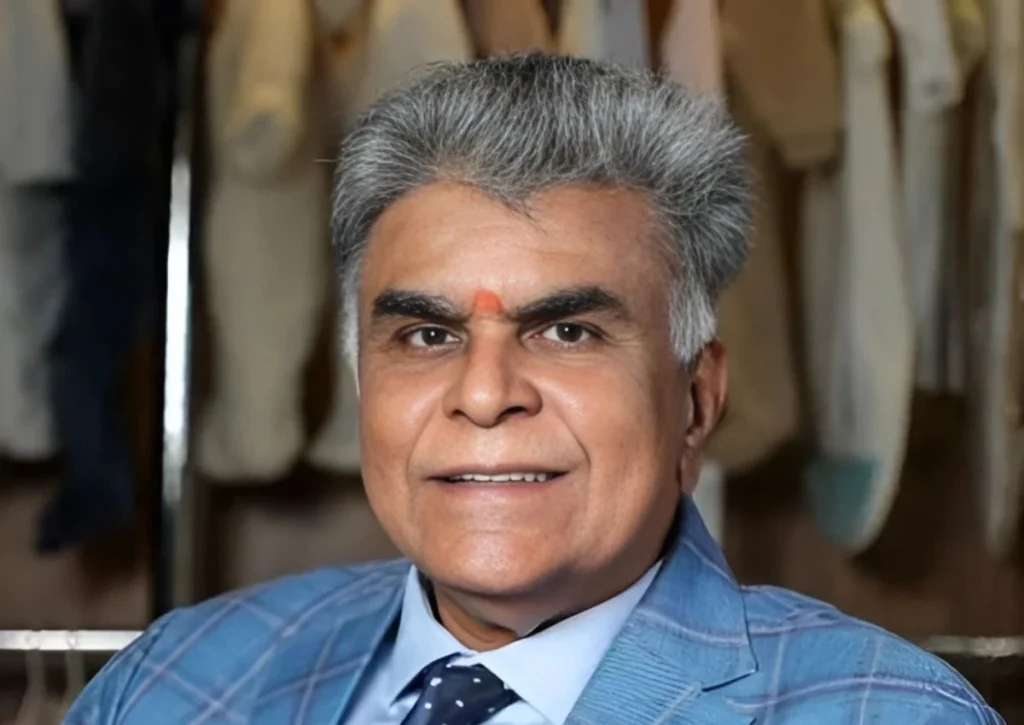Navratri: The festival of Navaratri is the joyous way of worshipping goddess Durga, who killed demon Mahishasura. Its name itself, made up of the two Sanskrit words ‘Nav’ (nine) and ‘Ratri’ (nights), aptly describes this festival which lasts for nine nights. Huge and fierce celebrations of the goddess Devi’s divine femininity throughout India, and all over the world now, Navratri is a time to worship Devi in full force. It is a time for fasting, feasting as well as rituals and merry making concluding with the victory of good over evil. The rich texture of rituals and symbols woven into the festival is a reflection of India’s diverse cultural past and landscape, according to which, celebrations vary across the country with localised traditions for different goddesses.
Navratri is a festival to commemorate goddess Durga, who vanquished the demon Mahishasura. The legend It relates how the mighty buffalo demon Mahishasura had made both the heavens and earth to tremble, and then for his destruction the gods deputed the goddess Durga.
In their extremity, the gods united their divine powers to produce a mighty female fighter Durga. Riding a lion carrying all the gods’ weapons in her hands, Durga battled Mahishasura for nine nights, finally killing him on the tenth day known as Vijayadashami or Dussehra. This is not just a myth this is the metaphor for the battle being waged between God and the darkness.

The 9 nights of Navratri are allocated to the nine incarnations of Durga which is the Navadurga: Shailaputri, Brahmacharini, Chandraghanta, Kushmanda, Skandamata, Katyayani, Kalaratri, Mahagauri and Siddhidatri.
Each form represents a distinct aspect of the goddess’s power and is worshipped on a specific night.
The celebration of Navratri is a reflection of spiritual and seasonal cycles. This festival is observed four times a year, the two most important being the Sharad Navratri (held in the months of September-October), and Chaitra Navratri (March-April). Sharad Navratri ending on Dussehra followed by the festival of Diwali is the more common one and is celebrated as a public event with great pomp. It signals the start of harvest season and a time for giving thanks and rebirth.
Throughout the Indian subcontinent, Navratri is a patchwork of several celebrations. In Northern India, the festival is synonymous with elaborate Ramlila performances, dramatic enactment of episodes from the lives of Lord Rama.
On the 10th day, called Dussehra, people Enjoys and burn Ravana effigies to mark the victory of good over evil. Puja In West Bengal and the eastern states of India, Navaratri is observed as Durga Puja. With massive pandals being set up to house intricately made idols of the goddess, the community is bustling with performances and food.
On the last day of Visarjan when they let the idols drown, it’s so emotional and final goodbye.
In western India and especially Gujarat Navratri is FULLY CELEBRATED! It’s time for Garba and Dandiya Raas, two traditional folk dances that are danced in big circles while clapping rhythmically or pounding small wooden sticks. The dances are elements of a community ritual: the costumes are three-coloured traditional ones.
The vibes are electric, and thousands dance past midnight. Likewise in Maharashtra, Navratri is observed with much fervour and women carry earthen pots filled with water and lighted up lamps signifying prosperity & life. And Southern India also has its own traditions. In states such as Karnataka, Tamil Nadu and Andhra Pradesh, Navratri is observed as Golu or Bommala Koluvu when dolls of gods and demi gods are displayed on a stepped platform the symbolic display of divine hierarchy and the story of creation.
Navratri is not just about religious observance – it’s a celebration of community, culture and the experience of shared joy. During Eid, it’s a time that everyone can unite and regardless of their beliefs and celebrate. “Fasting, for many of us who follow it for the nine days, is not just a religious custom; it is also a form of abstinence and detoxification you clear your mind and body in order to prepare yourself like the animals preparing for hibernation in winter,” Mr. Awasthi said. Community bonding The binging on vrat (fasting) snacks like sabudana khichdi, kuttu ki puri and an array of fruits becomes a collective affair in itself.
Astoundingly, the festival of Navratri has crossed barriers of distance and is extravagantly celebrated in many countries across the globe, courtesy a huge Indian diaspora. The fundamentalities remain the same, but they usually acquire a style and flavour of their own as they are grafted on to the local culture and traditions of the inmate country.
USA has become one of the major hubs for Navratri celebrations. Indian populated cities like New Jersey, New York, Chicago and Houston organize major Garba and Dandiya nights. Organized by Indian associations and temples, these events lure thousands of participants both Indian expatriates and locals. Festivities in the US are known for their fun, traditional Indian clothes and of course a little combination of both worlds with fafda jalebi served along with American plates.

One of the most lively Navratri festivities outside India takes place in the UK. There’s an outpouring of festive cheer in the big cities, from Wembley to Leicester and Birmingham. Especially the city of Leicester is famous for holding the largest Navratri festival in Europe, a night long Garba with almost thousands of people. The UK has its own celebrations, which bear witness to the close link between Indian culture and language amongst its people who manage to conjure up that same magic and spirit of Navratri within an array of thousands of miles.
Canada, too, is no exception to the spirit of Navratri. In cities such as Toronto and Vancouver, which have higher proportion of diverse communities, it’s a big celebration. Other cultural groups such as the Gujarat Samaj of Toronto also hold big events, which are known to sell out, demonstrating the popularity of the festival. Canadian dandiya and raas celebrations are a mixture of cultures where the sound of Garba drums is blended with traditional Indian outfits, and everyone dances to it under colours of beautiful autumn leaves truly once in a lifetime experience!
Navratri, the festival of dance and devotion is also becoming popular in Australia, withIndian expats as well as locals partaking in the Garba nights hosted in Sydney, Melbourne to Brisbane. The festival is a wonderful opportunity to share culture, particularly for the younger generation of Australian Indians who have more Aussie mates than Indian ones.
It may come as a surprise even in African countries like Kenya people are crowding to celebrate Navratri. Kenya boasts one of the most established and dynamic Indian diasporas outside India, particularly in Nairobi and Mombasa, the story says. Navratri will take place later this month as a large cultural event, with events at area Hindu temples and community centers.
They are striking examples of cultural blending where on one hand, you get to listen to traditional Gujarati folk music laced with African rhythms occasioning an environmental orgy.
In nut shell we when celebrate Navratri? Its not just celebration of a festival but its colorful way we invite power, life and triumph over evil. From traditional puja in Indian homes and temples to Garba nights in metropolitans around the world, Navratri is something that blends cross cultural appeal. It’s a strong representation of the energy and vitalize of the divine feminine in all its forms, and an incredible message about how longstanding cultural symbol can withstand thousands of years. The world wide prevalence of Navratri festivals also reaffirms the fact that it is a great unifier, helping people bond together, reminding them that cultural demarcations disappear in front of the shared devotion and gaiety.
Also check:- Quick and easy meal prep for hectic days




